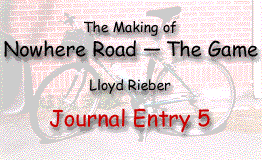

OK, I got excited. I started to actually enjoy playing the game. Take a moment to understand the significance of this statement. The game was triggering the "challenge chip" inside my head. That is, the game was difficult enough to make me concentrate, but not so difficult that I got frustrated and gave up. This made me want to find some people to show the game to. I went to the Studio lab and starting grabbing people saying "Come here, take a look at this." It is my opinion that one can only be considered a "designer" when you build something which makes you want to try it out with people and (this is important) you want to earnestly find out if you are on the right track. It reminds me of the times that as an elementary classroom teacher I had thought of something clever for a lesson and really looked forward to getting into the classroom with my students to to see what their reactions would be. All too often, I see many people build something and then are so protective of it that they are actually offended if a typical user doesn't "get it" right away. One of the advantages of having the attitude of "I am only building a prototype" is that you know you can change directions quickly based on what happens when people actually use the stuff.
I made only one significant modification to the prototype before showing it to folks -- I modified it so that that roadway only appeared in the "front view" box (i.e. I hid the edges of the roadway outside of this screen box. (This modification took only about 15 minutes.)
Most of the people in the lab were Studio students who already heard me talk about my little project, but had never seen any tangible evidence of it. So those I pulled by the arm to the computer where I had it set up were going to get their first real dose of "Nowhere Road - The Game".
I appreciate the significance of a product's "intraocular test of validity" -- whether or not it strikes someone "right between the eyes" as significant (or cool) enough to be worth their time. Not all products are subject to this test, but I think this game is. If it doesn't strike folks within the first 10 seconds or so that it ought to be explored, they will drop it and move on with their life. I also realize how my own enthusiasm might unfairly bias a person's perception of the product. So, I was mindful not to ruin the moment. But hey, it's only a first try for a handful of people -- no need to get too intellectual.
So, what did I find out?
First of all, I really felt that the individuals who tried it out were not trying to please me. The reason is that as they started to play the game, a gush of ideas started to flow about how to improve the game. Yet, they really showed all the typical non-verbal cues associated with having fun, such as lots of smiles. Let's face it, the idea of going on a bicycle ride on Nowhere Road is rather disarming. The very thought of it is both fun and mildly eccentric. Plus, the atmosphere was informal enough to suggest to everyone that nothing was 'at stake' if they noticed problems. Everyone knew this was "only a prototype".
But, the fact that they were willing to make lots of suggestions meant that they weren't just trying to placate 'the professor'. There were also many places where confusion arose. Here is a quick summary of the suggestions and 'trouble spots':